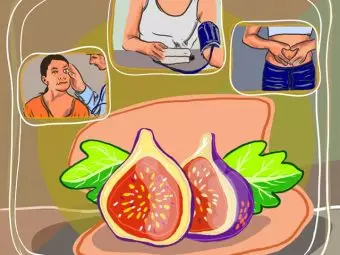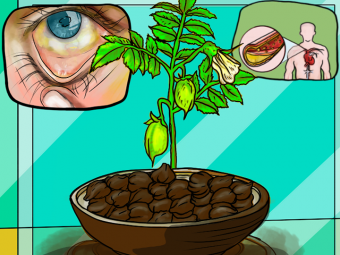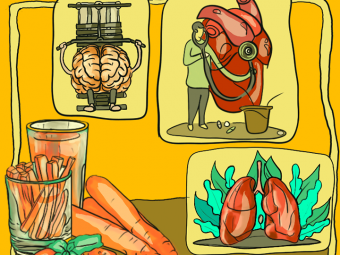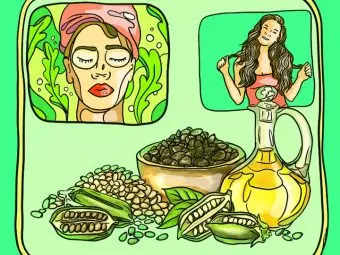Sugar snap peas are formed from a cross between the garden peas and snow peas. The many sugar snap peas benefits arise from this unique hybrid nature. In contrast to other varieties of peas, sugar snap peas are sweeter, tastier, and you can eat the whole pod. You can add them to various dishes, including salads and stir-fries. They are also packed with nutrients and health benefits. Let’s find out how you can use them. Read on.
In This Article
Are Sugar Snap Peas Good for You?
Yes, sugar snap peas are starchy and nutrient-dense vegetables and can be eaten raw, cooked, or steamed. They have a crunchy texture, and you can eat the entire pod. The good part is that the glycemic load of sugar snap peas is 5, so they will not increase your sugar levels. Check out the nutrient profile of sugar snap peas in the next section.
Sugar Snap Peas Nutrition
A hundred grams of sugar snap peas contain (1):
|
Calories |
41 kcal |
|
Protein |
2.35 g |
|
Total lipids (fat) |
0 g |
|
Carbohydrate |
7.06 g |
|
Dietary Fiber |
2.4 g |
|
Sugar |
3.53 g |
|
Calcium, Ca |
44 mg |
|
Iron, Fe |
2.35 mg |
|
Potassium |
200 mg |
|
Vitamin K |
24.5 mcg (31% of daily value) |
|
Vitamin A |
1065 IU (21% of daily value) |
|
Vitamin C |
58.8 mg (98% of daily value) |
This nutrient and antioxidant-rich vegetable has many health benefits. Let’s take a look at them.
Health Benefits Of Sugar Snap Peas
1. Improve Bone Health
Sugar snap peas contain vitamin K, which helps maintain bone health, increases bone mineral density, and reduces fracture rate in people with osteoporosis (2). Pea proteins contain biopeptides, which promote osteoblast proliferation (cells that make the bone) and differentiation and procollagen development to improve bone function in people with osteoporosis (3).
2. Boost Immunity
Sugar snap peas contain vitamin C, an antioxidant that supports various cellular functions and boosts the immune system. It supports epithelial barrier function, which is crucial to protect the body against pathogens (4). Adequate intake of vitamin C can reduce the risk of pneumonia, malaria, and diarrhea in children (5).
3. May Boost Gastrointestinal Function And Health
Sugar snap peas contain fiber, which is crucial for improving digestion and gastrointestinal health. They promote overall gut health and functions like nutrient absorption, stool formation, and functions of gut-friendly microbes (6) (7).
4. May Prevent Fatigue
Animal studies found that pea peptides significantly reduced fatigue. Consuming peas also decreased blood urea nitrogen (BUN) and lactic acid levels in the blood (8). Blood urea nitrogen and lactic acid are produced during ATP metabolism (the energy source for cell function) and cause fatigue (9).
5. May Decrease The Risk Of Cardiovascular Diseases
Sugar snap peas are low in calories and do not contain fat, which makes them heart-friendly. Pea fiber can reduce postprandial (post-meal) triglyceride buildup in the body, which is one of the major causes of cardiovascular disease (10), (11).
6. May Help Protect Vision
Peas contain lutein and zeaxanthin, which can protect the eyes from macular degeneration, a condition that affects the macula in the retina and causes vision-related issues (12).
Sugar snap peas are available in spring (April to June). Fresh snap peas are light green and have a sweet aroma. You can consume them raw or cooked. Here is how you can add them to your diet
How To Eat Sugar Snap Peas: Healthy Recipes You May Try
You can roast them, pickle the entire pods, and add them to stir-fried dishes. Here are some tasty recipes you may try:
1. Sugar Snap Peas Stir Fry
What You Need
- 200 g of sugar snap peas
- 1 tablespoon of sesame seeds
- 1 tablespoon of sesame oil
- 3 tablespoons of olive oil
- 2 chopped garlic cloves
- 1 teaspoon of chopped ginger
- 20 mL water
- 1/4 teaspoon of pink salt or iodized salt
Method
- Dry roast the sesame seeds on low heat.
- Warm olive oil on medium heat and fry chopped garlic and ginger for two minutes.
- Add the peas and stir fry them for a minute.
- Add the water, cover the pan with a lid, and cook for three minutes.
- Sprinkle salt and sesame oil for the finishing touch.
2. Sauteed Sugar Snap Peas And Tofu
What You Need
- 300 g of sugar snap peas
- 100 g of tofu
- 4 tablespoons of olive oil
- 1 teaspoon of chopped ginger
- ½ tablespoon of minced garlic
- ½ teaspoon of mustard seeds
- 1 teaspoon of salt
Method
- Warm olive oil on medium heat. Add the tofu pieces, chopped ginger, and garlic. Fry for two minutes.
- Add the mustard seeds, let them splutter, and then add the snap peas. Sauté
for five minutes. - You can also add boiled potatoes to the recipe or serve mashed potatoes on the side to make it one wholesome meal.
3. Honey Glazed Carrots and Sugar Snap Peas
What You Need
- 200 g of sugar snap peas
- 1 large carrot (thinly sliced)
- 4 tablespoons of honey
- 2 tablespoons of butter
Method
- Add butter to a frying pan. Add the carrots and fry for a few minutes on medium heat.
- Add the sugar snap peas and fry on medium heat until they are crisp.
- Add honey, stir for another minute, and serve hot.
Here are some additional tips to help you pick the freshest sugar snap peas and store them.
How To Store Sugar Snap Peas
- Always buy bright green and glossy peas, without any yellowing or speckled areas. Avoid the ones with loose peas rattling inside the pod.
- For storing, wash them with water, wipe them or air dry, and then put them in perforated plastic bags or glass containers. You can refrigerate them – however, use them within a week.
- You can also freeze them. Wash the sugar snap peas, pat them dry, and thaw them. Transfer the thawed peas to a plastic bag and seal it tightly. You can use frozen sugar snap peas for a month. Discard them if they turn sticky or give out a foul smell.
Sugar snap peas are possibly safe when consumed in moderation. However, they may cause minor side effects when consumed in excess.
Side Effects Of Sugar Snap Peas
1. May Cause Bloating
Sugar snap peas are rich sources of dietary fiber, and excess dietary fiber may cause bloating (13).
2. May Worsen Diarrhea
Anecdotal evidence suggests that sugar snap peas may worsen diarrhea and cause abdominal cramps and stomach discomfort.
Subscribe
3. May Cause An Itchy Throat
If you are allergic to sugar snap peas and legumes, it may cause an itchy throat and coughing.
Usually, these symptoms subside on their own once you stop eating sugar snap peas. However, if the symptoms persist after 48 hours, consult your doctor immediately.
Sugar snap peas are starchy and nutrient-dense vegetables. The many benefits of sugar snap peas can be attributed to their rich nutrition profile and antioxidants. The intake of this vegetable may improve bone health, boost immune health, promote gastrointestinal function, prevent fatigue, decrease the risk of cardiovascular diseases, and protect vision. You can eat sugar snap peas in many ways. You can roast the peas and add them to stir-fried dishes. However, if you consume them in excess amounts, they may cause bloating, worsen diarrhea, and cause an itchy throat. Hence, eat them in moderation to reap their maximum benefits.
Also, be aware if you are allergic to these.
Frequently Asked Questions
Do sugar snap peas make you gain weight?
No. Many anecdotal studies suggest that sugar snap peas may help with weight loss due to their low calorie and fat content.
Can you eat the shell of snap peas?
Yes. You can eat the shell of snap peas. In general, the whole pod of snap peas is edible. However, strings along the edges are removed before consumption.
What is the difference between snap peas and snow peas?
Sugar snap peas are a cross between garden peas and snow peas. Unlike flatter snow peas, snap peas are slightly tender with a sweet flavor and have a thicker, crunchy pod.
Can I boil sugar snap peas?
Yes. A quick blanching of sugar snap peas in boiling water is needed before eating.
What’s the difference between snap peas and edamame?
Snap peas can be eaten whole and have a slightly sweet taste. Edamame has a bitter taste, and you can eat only the pods.
Key Takeaways
- Sugar snap peas are nutrient-dense, starchy vegetables that can be consumed raw, cooked or steamed. You may use them in various dishes, such as salads and stir-fries.
- These peas enhance the immune system, promote digestion and gastrointestinal health, reduce fatigue, lower the risk of cardiovascular disease, and protect vision.
- When eaten in moderation, sugar snap peas may be harmless. However, excess intake may cause minor adverse effects such as bloating, worsening diarrhea, itchy throat, and coughing.
Sources
Articles on StyleCraze are backed by verified information from peer-reviewed and academic research papers, reputed organizations, research institutions, and medical associations to ensure accuracy and relevance. Read our editorial policy to learn more.
- Sugar Snap Peas
https://fdc.nal.usda.gov/fdc-app.html#/food-details/509255/nutrients - Vitamin K and bone health
https://pubmed.ncbi.nlm.nih.gov/11684396/ - Pea Protein Derived Bioactive Peptides Stimulate Bone Health-Promoting Effects
https://era.library.ualberta.ca/items/9cbbc994-c63d-4804-90f3-2547cc73d004/view/cb10a674-7f7c-4165-b7d9-a446c40993fa/Arora_Harshita_202002_MSc.pdf - Vitamin C and Immune Function
https://www.ncbi.nlm.nih.gov/labs/pmc/articles/PMC5707683/ - Immune-enhancing role of vitamin C and zinc and effect on clinical conditions
https://pubmed.ncbi.nlm.nih.gov/16373990/ - Review of the health benefits of peas (Pisum sativum L.)
https://pubmed.ncbi.nlm.nih.gov/22916813/ - Dietary fiber in gastrointestinal health and disease
https://pubmed.ncbi.nlm.nih.gov/33208922/ - Anti-fatigue effects of pea ( Pisum sativum L.) peptides prepared by compound protease
https://pubmed.ncbi.nlm.nih.gov/33967323/ - Muscle fatigue: general understanding and treatment
https://www.ncbi.nlm.nih.gov/labs/pmc/articles/PMC5668469/ - Postprandial Lipemia as Cardiovascular Disease Risk Factor
https://www.intechopen.com/chapters/69909 - Pea fiber lowers fasting and postprandial blood triglyceride concentrations in humans
https://pubmed.ncbi.nlm.nih.gov/16856319/ - The Effect of Lutein on Eye and Extra-Eye Health
https://www.ncbi.nlm.nih.gov/labs/pmc/articles/PMC6164534/ - Management Strategies for Abdominal Bloating and Distension
https://www.ncbi.nlm.nih.gov/labs/pmc/articles/PMC4991532/
Related
The following two tabs change content below.
- Author
- Reviewer

Aparna Mallampalli
Aparna is a professor-turned-content writer with over 5 years of experience in life sciences. Her passion for writing and interest… more
Shivani Sikri
(PG Diploma in Dietetics & Public Health Nutrition)Shivani Sikri is the founder and chief nutritionist at Nutri4Verve and has more than 10 years of experience. She recommends… more



 29 Amazing Benefits Of Figs For Skin, Hair And Health
29 Amazing Benefits Of Figs For Skin, Hair And Health 19 Amazing Benefits Of Black Chickpeas (Kala Chana) For Skin, Hair And Health
19 Amazing Benefits Of Black Chickpeas (Kala Chana) For Skin, Hair And Health 28 Best Shea Butter Benefits For Skin, Hair And Health
28 Best Shea Butter Benefits For Skin, Hair And Health 15 Best Benefits Of Beta Carotene For Skin, Hair And Health
15 Best Benefits Of Beta Carotene For Skin, Hair And Health 29 Amazing Benefits Of Sesame Seeds For Skin And Health
29 Amazing Benefits Of Sesame Seeds For Skin And Health 4 Reasons Goat Cheese Is Better Than Cow Cheese
4 Reasons Goat Cheese Is Better Than Cow Cheese 38 Benefits Of Lime For Skin, Hair, And Health + Nutrition
38 Benefits Of Lime For Skin, Hair, And Health + Nutrition Rice Water For Skin – How To Use It For Maximum Benefits
Rice Water For Skin – How To Use It For Maximum Benefits 9 Benefits Of Cranberry Tea For Health And Recipes To Try
9 Benefits Of Cranberry Tea For Health And Recipes To Try